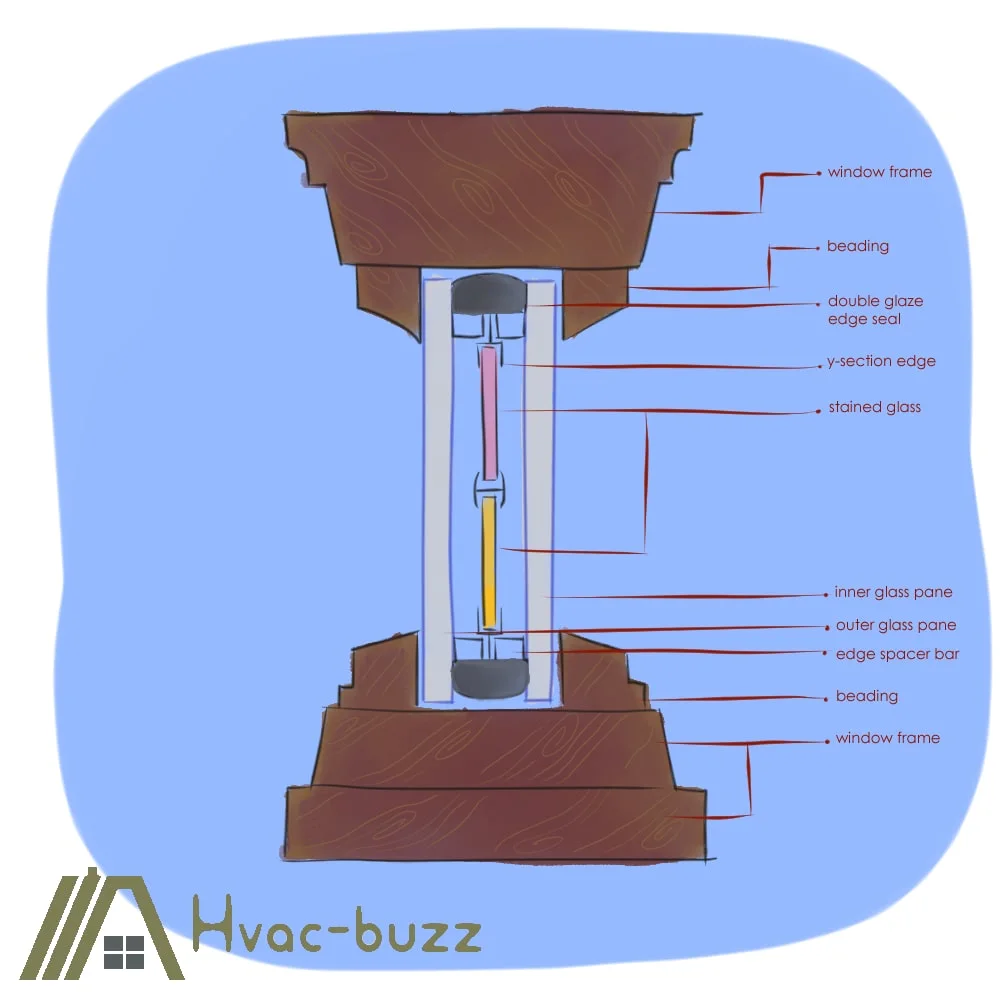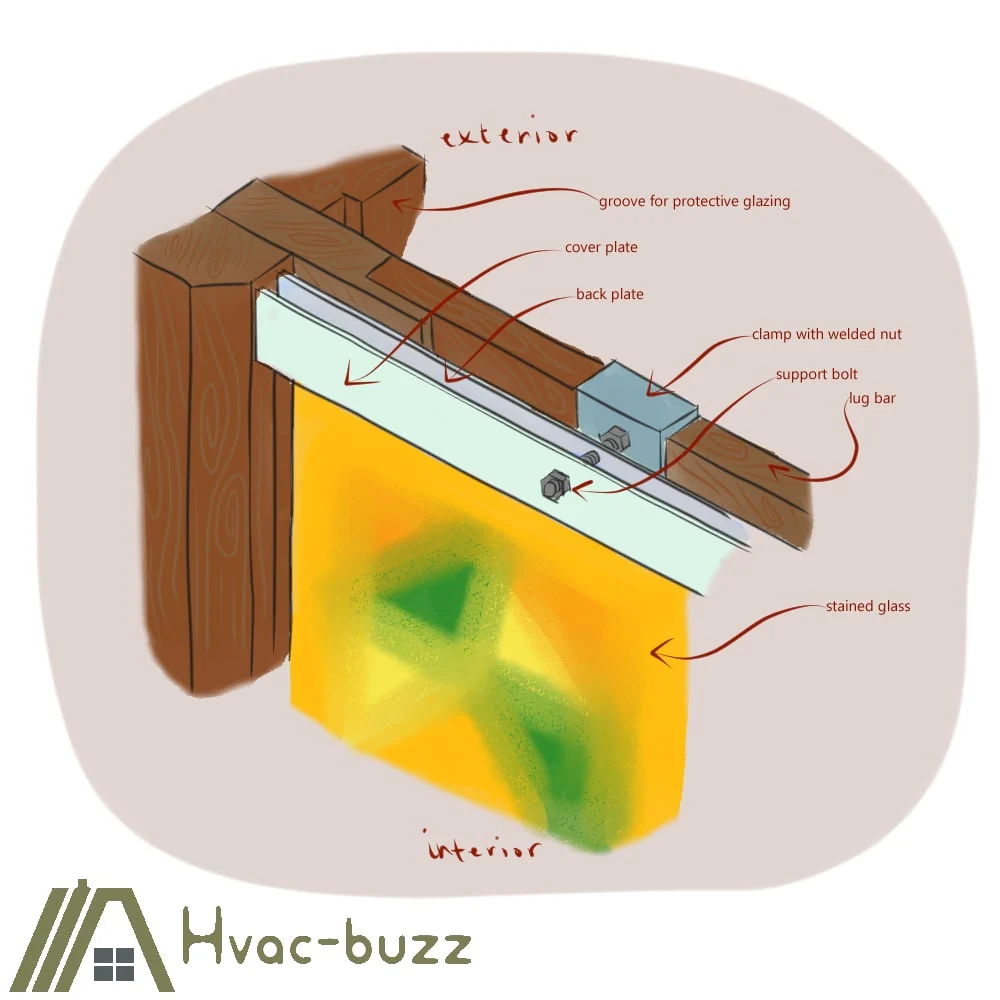I have always been captivated by the enchantment of stained glass windows. Still, I have doubted the practicality of their incorporation into a home, as they seem tricky to insulate.
Modern homes need to be energy efficient, not only for the sake of our wallets but also in the interest of lowering our carbon footprints. Double glazing is a common method for increasing energy efficiency, but what are the possibilities and implications of doing so with stained glass? Keep reading and I will take you through the answers to these questions and more.

Stained glass can be double glazed with a panel of regular glass, triple glazed by being encapsulated between two regular panes, or isothermally glazed, which is a variation of double glazing, incorporating ventilation. Glazing stained glass windows improves insulation and protects the stained glass.
Double Glazing Stained Glass
Stained glass can be glazed, including double glazing. It can be glazed with tempered glass to make it sturdier, especially since the stained glass itself cannot be tempered. Two common glazing techniques are used with stained glass windows: encapsulation and isothermal glazing.
Sealed Encapsulation – Double and Triple Glazing
With this method, the stained glass is sealed and sandwiched between two panes of “regular” glass to create triple glazing, or the stained glass is sealed to an outer regular glass pane to create double glazing.
This sealed encapsulation method is most commonly used in homes where the window frame is easily replaced.
The thickness associated with triple glazing can compromise the aesthetics of the glass due to the distortion of light waves. Condensation between the panes can become a problem if the seal is compromised (I go over this in more detail later).

Isothermal Glazing
Isothermal glazing aims to reduce condensation by using ventilation to raise the temperature above the dew point.
In isothermal glazing, the protective glass sheet is placed in the outer groove of the window frame, and the stained glass pane is placed in the most forward or internal groove. Discreet vents are strategically placed near the top and bottom of one pane to create a chimney-like ventilation effect.
External ventilation is when the vents are placed in the protective sheet, and internal ventilation is when the vents are placed in the stained glass window.
External ventilation allows normalization of the outside atmosphere with the space between the glazing and the internal ventilation. Conversely, internal ventilation allows normalization with the internal environment of the home or church.
External ventilation is not always a great option because it can allow driven rain and windblown debris to enter the space between the glazing and stained glass.
Isothermal glazing allows more natural light to strike the window and does not compromise the aesthetics as much as encapsulation techniques do.
Additionally, isothermal glazing neatly addresses the issue of condensation.
However, isothermal glazing does not provide as much insulation as encapsulation techniques and cannot be used with certain casement styles.

A new type of double-pane window, known as a vacuum-sealed window, has come onto the market (well, it’s relatively new, anyway). However, it is not appropriate to vacuum-seal stained glass as the pressure created would damage the art.
Does Glazing Make Stained Glass Look Hazy?
Correctly installed and sealed double glazing won’t make your stained glass look hazy, but mistakes can affect the aesthetics of your stained glass.
Encapsulated units are supposed to have an airtight seal. However, this seal can be compromised for a variety of reasons. Once the seal has been compromised, condensation will appear between the glazing and the stained glass window. The “blown” windows will have a hazy appearance.
Furthermore, increased condensation will also create an ideal environment for mold to grow, as well as result in the chemical breakdown of the cement, lead, and paint.
Stained glass windows may also appear hazy if spiders decide to make their homes between the glazing and the stained glass in ventilated (isothermally glazed) units. The spiders will be grateful to the homeowners for creating a spider sunroom, but the homeowners will be frustrated by the web-festooned glass!
Finally, as mentioned previously, the thicker the width of the sealed unit, the greater the amount of natural light blocked from passing through the stained glass. The vibrancy of the colors may be compromised if the unit is not made as slim as possible.
How Much Is Added to the Dimensions of the Glass?
Double and triple glazing requires broader window frames than the traditional timber frames of stained glass windows.
The standard spacers used in encapsulation are 25 mm (approximately 1”). Standard uPVC window frames will be between 20 mm (0.79”) to 28 mm (1.1”) thick to accommodate the glazing thickness and spacers.
Slimline 13 mm (approximately 0.5”) spacers are available and slimline frame designs allow more natural light into the window, however, they cannot accommodate the thickness of stained glass windows.
If the window frame has historic value, it is preserved by adding metal or wood extenders containing additional tracks. The encapsulating sheet is fitted into the original track. The stained glass window is moved forward (toward the interior of the building), where it slots into the new groove in the extended portion of the window frame.
Typically, the stained glass windows will need to be cut down to fit into the thicker uPVC frames associated with glazing. Not all stained glass window designs can afford to sacrifice a portion of the border, in which case two options are open to you:
- Creating a custom frame with narrowed sash frames and mullions.
- Enlarging the casement area for the window frame.
Can I Double Glaze My Own Stained Glass Windows?
Unless you are extremely proficient at stained glass restoration and installing double glazing, I would advise you to avoid this highly technical project.
However, for those who are determined to take ownership of a project and have a “can-do” attitude, I would strongly suggest you contact a restoration expert for advice. These experts will be able to assess the level of restoration needed on your stained glass and advise on the best glazing technique for your house.
Stained glass windows made within the past decade should require little to no restoration, and thus the installation of glazing is much simpler and may be a more doable task for non-professionals.
Can You Double Glaze Stained Glass Normally?
Stained glass windows can be glazed using standard techniques if the stained glass does not need to be made smaller and if no restoration work is needed.
Preservation of historic stained glass windows is more technical and will require in-depth analysis of the window’s integrity, condensation, and airflow patterns. The glazing techniques used will vary based on these factors and whether the original frame is being retained.
Is it Expensive to Double Glaze Stained Glass?
If a stained glass window is custom-made for a modern home that uses double glazing, it will be no more expensive than encapsulating a clear pane window.
However, the cost will be more than standard encapsulation when restoring, preserving, or re-purposing stained glass windows for home use. The price will differ from job to job-based on the amount of restoration required, the frame and casement adjustments needed, the size of the window, and the glazing technique used.
Is it Worth it?
Many benefits are obtained through glazing stained glass windows.
- Improved insulation and reduction in utility costs. While encapsulation of stained glass windows provides superior insulation, isothermal glazing will still enhance energy efficiency by approximately 80%.
- Both encapsulation and isothermal glazing allow the stained glass to be preserved in an almost museum-like environment through the regulation of airflow, temperature variances, and condensation.
- Protection from the elements. All glass is vulnerable to mechanical damage by the elements. Losing a one-of-a-kind piece of art to rain or wind is a heart-wrenching loss for any homeowner or preservationist.
- Protection from vandalism and improved home security. The tough pane of glass used for glazing is usually reinforced and more resistant to breakage than standard glass, deterring any would-be intruder from entering your house via your gorgeous stained glass windows.
- Double glazing is recommended in areas that suffer from frequent wildfires. You can read more in my article on Can Stained Glass Start a Fire.
Stained glass is the legacy of a bygone era, where artists told a story, and the everchanging tapestry of light invited the fairies to dance upon the stone flags of historic churches and aristocratic homes. Glazing stained glass windows allow us to preserve that magic for future generations, so I would say definitely worth it!
Sources
http://www.morningglass.co.uk/news/2012/10/11/encapsulation-of-stained-glass
https://www.buildingconservation.com/articles/protective-glazing/protective-glazing.htm
https://www.knowlesstainedglassworks.co.uk/the-encapsulation-process/
https://www.buildingconservation.com/articles/protective-glazing/protective-glazing.htm
